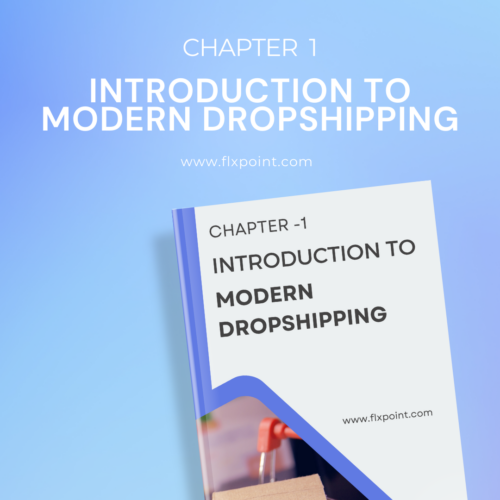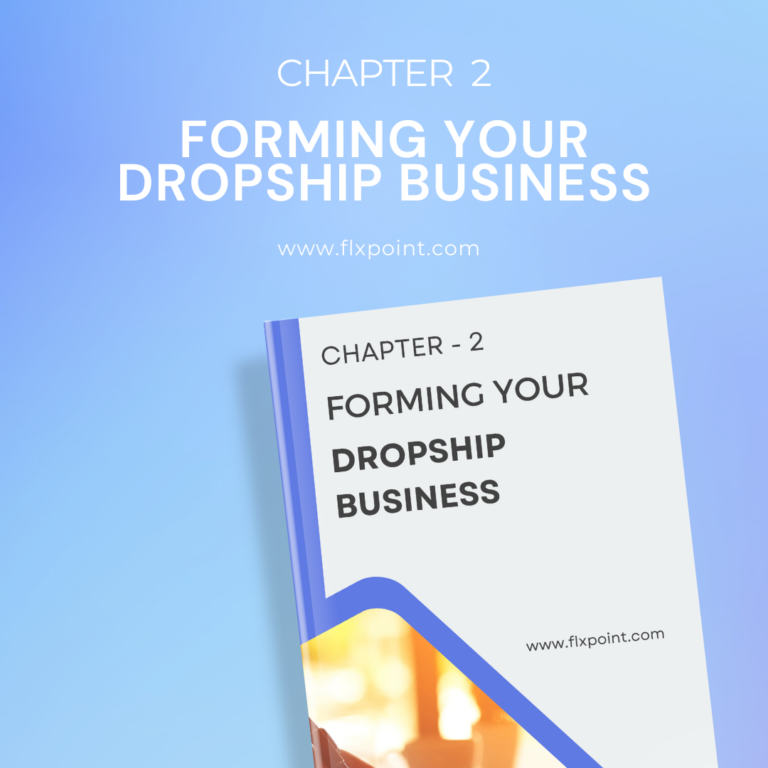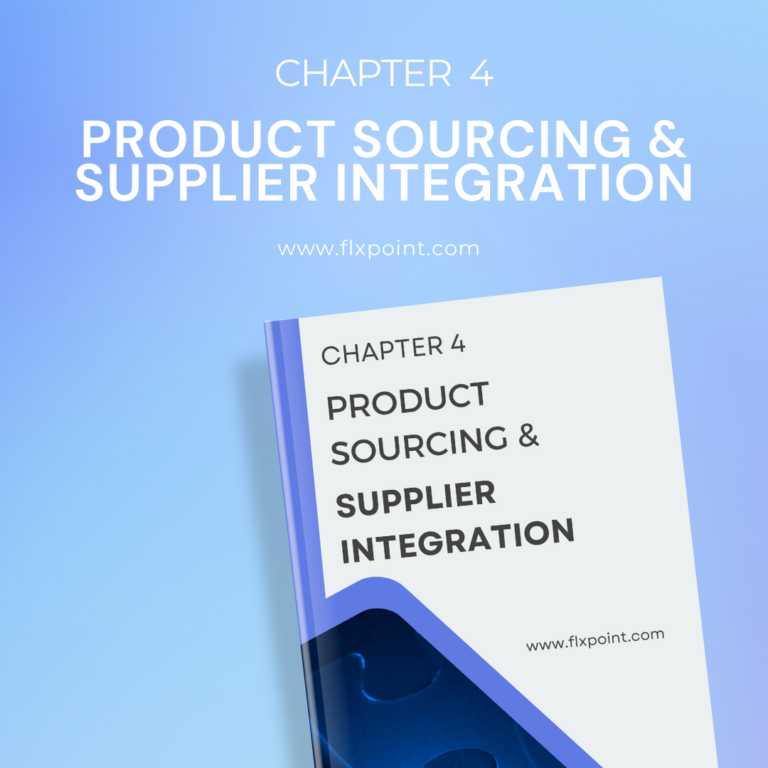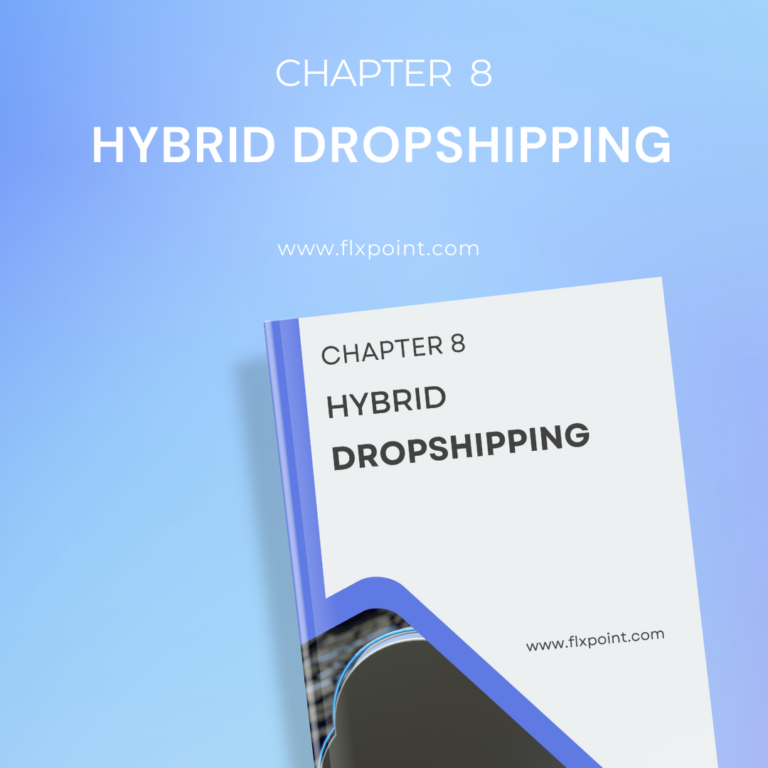Chapter 6 Dropship Pricing Strategies
Set competitive yet profitable prices. Explore various pricing strategies like cost-plus, value-based pricing, and psychological pricing to maximize your earnings.

Introduction to Dropship Pricing Strategies
Pricing is a vital aspect in dropshipping as setting the right price will affect your profit margins and your competitiveness in the market. The pricing strategies are essential for balancing affordability with profitability, as you need to cover supplier costs, shipping, and other expenses while still attracting customers.
One of the major challenges is maintaining the pricing in the competitive market without sacrificing profit margins. To overcome this kind of challenge, businesses turn to tools like Flxpoint Pricing Automation. This helps streamline price adjustments and optimize profits.
In this chapter, we will explain and explore the key pricing models, cost-plus, value-based, and dynamic pricing as well. We’ll also discuss adjusting prices based on supply chain changes, customer demands, and how Flxpoint automation tools can help.
How to Set Competitive Prices While Maintaining Profitability
The goal is to attract customers with appealing prices while ensuring that your business remains profitable. This balance requires careful consideration of several factors and the use of smart pricing strategies.
Balancing Competitive Prices with Profit Margins.
The prices you set should be attractive to customers. If the pricing is too low then it can cut into your profit margins. You have to strike the right balance which can be done by calculating all the costs involved, the price you pay your suppliers, and additional expenses like shipping and taxes. This will ensure that your profit margins are the key to long-term success.
Factors to Consider – Supplier Costs, Shipping, Taxes, and Marketplace Fees.
- Supplier Costs – The price you pay for your products directly affects your margins. Choose reliable suppliers with stable pricing.
- Shipping Costs – Shipping expenses can vary widely depending on the product and destination. Incorporate these costs into your final pricing.
- Taxes – Be mindful of tax obligations in different regions. Factor this into your pricing strategy to avoid unexpected costs.
- Marketplace Fees – Platforms like Amazon and eBay charge seller fees, which can impact your overall profit. Include these fees in your pricing formula.
Using Data-Driven Tools to Optimize Pricing Decisions.
- Flxpoint Pricing Automation – Flxpoint automates price adjustments based on real-time data, allowing you to optimize profit margins.
- Sales Analytics – Track your sales performance to identify high and low-performing products and adjust prices accordingly.
- Competitor Analysis – Use tools to monitor competitor pricing and ensure your products are competitively priced without cutting into profits.
Pricing Strategies for Dropshipping
Cost-Plus Pricing
Cost-plus pricing is a simple method where you add a fixed markup to the base cost of a product to determine its selling price. For example, if a product costs $10 and you add a 30% markup, the final price would be $13.
Pros and Cons of Dropshipping.
Pros:
- Easy to calculate.
- Ensures consistent profit margins.
Cons:
- It may not be competitive if your markup is too high.
- Doesn’t consider market demand or competitor pricing.
Value-Based Pricing
Value-based pricing sets prices based on what customers think a product is worth, not just its cost. This strategy works best for products with unique features or benefits that set them apart. By charging what customers are willing to pay, you can attract high-value customers and increase profit margins. Automated pricing tools like Flxpoint can help you implement this strategy effectively, adjusting prices based on market demand to optimize your dropshipping business.
Dynamic Pricing
Dynamic pricing is a strategy that involves adjusting prices based on market demand, competition, and other factors. This helps dropshippers stay competitive and respond quickly to changes in the market. For example, if a product is in high demand, prices can be increased to maximize profit margins. Conversely, prices may be lowered to attract customers when demand is low.
Benefits of Real-time Price Adjustments.
- Maximizes Profit Margins – Increase prices during high demand to boost revenue.
- Stays Competitive – Reacts to competitor pricing quickly, ensuring competitive pricing.
- Enhances Sales – Attracts more customers by lowering prices when needed.
- Optimizes Inventory – Helps manage stock levels by adjusting prices based on availability.
- Utilizes Flxpoint Pricing Automation – Automates adjustments, saving time and reducing errors.
Psychological Pricing
Psychological pricing is a strategy that uses specific pricing tactics to influence consumer behavior. One common tactic is ending prices in .99, making them appear more attractive to buyers.
For example, a product priced at $19.99 feels cheaper than one priced at $20. This small difference can significantly impact purchasing decisions. In dropshipping pricing strategies, using psychological pricing can help achieve competitive pricing while maintaining profit margins. Utilizing tools like Flxpoint pricing automation can further enhance these strategies by automating price adjustments based on consumer behavior trends.
The Impact of Psychological Pricing on Customer Behavior.
- Perception of Value – Lower-ending prices create a perception of value.
- Increased Sales – Customers are more likely to buy when prices seem lower.
- Encouragement to Purchase – Psychological pricing can trigger impulse buying.
- Brand Positioning – It can enhance brand perception as budget-friendly.
Specific Pricing Models in Dropshipping
Fixed Markup on Cost
Fixed markup on cost is a straightforward pricing model where a specific percentage is added to the product’s cost to determine the selling price. For example, if a product costs $50 and the fixed markup is 30%, the selling price would be $65. This method helps maintain consistent profit margins. Best practices for setting markup percentages include:
- Research Your Market – Understand what competitors charge for similar products to ensure competitive pricing.
- Consider Costs – Factor in all costs, including shipping and fees, to maintain profitability.
- Test and Adjust – Experiment with different markups to see what maximizes sales and profit.
- Use Flxpoint Pricing Automation – Automate markup adjustments based on real-time data to optimize profit margins.
Tiered Markup on Cost
Tiered markup on cost is a pricing strategy where different markups are applied based on the product’s cost. For example, lower-cost items may have a higher percentage markup, while higher-cost items might have a lower markup. This approach allows businesses to adapt their pricing based on the product’s value and market demand.
- Optimizes profit margins – Adjusts markup based on product cost, maximizing profits.
- Encourages sales of high-value items – Lower markups on expensive products can attract more buyers.
- Balances competitive pricing – Helps maintain competitive pricing while ensuring profitability.
- Simplifies pricing structure – Provides a clear strategy for pricing decisions using Flxpoint pricing automation.
Mark-Down from MSRP
Mark-down pricing involves offering products at a discount from the Manufacturer’s Suggested Retail Price (MSRP). This strategy allows dropshippers to sell items at a lower price than competitors, attracting more customers while maintaining visibility on various platforms. By discounting below MSRP, businesses can increase sales volume and clear out slow-moving inventory.
- Competitive Edge – Offering lower prices than competitors boosts your appeal.
- Seasonal Discounts – Move products faster during sales seasons.
- Clear Inventory – Offload slow-moving items without cutting into profit margins.
- Increase Sales Volume – Attract more customers to drive revenue.
- Flxpoint Integration – Use Flxpoint pricing automation to manage mark-downs efficiently.
Manufacturer Suggested Retail Price (MSRP)
The Manufacturer Suggested Retail Price (MSRP) serves as a key reference point for pricing in dropshipping. It helps businesses maintain consistent pricing across platforms, ensuring competitive pricing while protecting profit margins. Using MSRP allows dropshippers to price their products competitively without undercutting the market. By leveraging MSRP, you can better align your pricing with industry standards.
- Compare the MSRP with your product costs to determine an optimal markup.
- Use MSRP to set a competitive price while preserving profit margins.
- Adjust prices using tools like Flxpoint pricing automation for dynamic adjustments based on market demand.
Psychological Pricing
Psychological pricing is a tactic used to influence customer perception of price. By leveraging subtle cues, you can make products appear more affordable or desirable. One common method is ending prices in .99, which makes customers perceive the price as lower than it actually is.
Another approach is offering discounts that create a sense of urgency or exclusivity. These strategies help increase sales while maintaining profit margins. In dropshipping pricing strategies, using psychological pricing alongside competitive pricing can make your products stand out. Flxpoint pricing automation can further optimize these tactics.
- Charm Pricing – Pricing products at $9.99 instead of $10.00.
- Bundling – Offering multiple products at a perceived discount to increase sales volume.
- Limited-Time Discounts – Using countdowns to create urgency and encourage quick purchases.
- Anchoring – Showing higher original prices next to discounted ones to highlight savings.
- Odd Pricing – Setting non-rounded numbers like $27.47 to make prices feel specific and calculated.
Adjusting Prices Based on Supply Chain Changes and Customer Demand
Real-time price adjustments are essential for this. Supplier costs and stock levels can change frequently, which directly affects your ability to offer competitive pricing. For example, if a supplier raises their prices or experiences stock shortages, maintaining outdated prices could erode your profit margins or lead to stockouts. By continuously monitoring supplier costs and inventory availability, you can adjust prices instantly, protecting both your profitability and customer satisfaction. Using tools like Flxpoint pricing automation helps make these adjustments seamless and efficient.
Adapting Prices During High Demand or Peak Seasons.
- During high-demand periods, like holidays or seasonal sales, consumer interest rises.
- You can adjust prices upward to reflect demand while maintaining competitive pricing.
- Avoid excessive price hikes that could alienate customers, but balance supply and demand effectively.
- Plan for anticipated peaks by preparing automated adjustments in advance using tools like Flxpoint.
How to Avoid Price Wars by Staying Flexible.
- Price wars can harm your profit margins if competitors start lowering prices aggressively.
- Stay flexible by focusing on value-added features, such as free shipping or bundles, rather than simply lowering prices.
- Use Flxpoint pricing automation to adjust prices in real time without drastically undercutting competitors.
The Role of Pricing Automation in Dynamic Adjustment.
Pricing automation allows you to track changes in supplier costs and inventory in real time. This helps maintain consistent profitability without manual intervention. Tools like Flxpoint pricing automation can automatically adjust prices based on pre-set rules, ensuring that your store stays competitive while protecting your margins. This is especially useful during supply chain disruptions, stock changes, or when dealing with multiple suppliers. Automating these adjustments helps businesses stay flexible and respond to market conditions effectively.
Flxpoint’s Pricing Automation Tools
Flxpoint offers powerful pricing automation tools that help streamline the entire pricing process for dropshipping businesses. Its key features include automatic price adjustments, real-time cost tracking, and customizable pricing rules. These tools allow businesses to set up dropshipping pricing strategies that react quickly to changes in supplier costs and market conditions.
Flxpoint’s system can automatically update prices based on supplier data, ensuring that businesses maintain competitive pricing while maximizing profit margins. It integrates seamlessly with various suppliers, offering accurate and real-time insights that help reduce manual efforts in price management.
How Flxpoint Helps Monitor Supplier Costs and Adjust Prices Accordingly.
- Real-Time Supplier Cost Tracking – Flxpoint monitors supplier pricing updates in real time, giving businesses access to the latest cost data.
- Automated Price Adjustments – It automatically adjusts product prices when there are changes in supplier costs, ensuring that prices remain competitive and profitable.
- Customizable Pricing Rules – Users can set specific pricing rules that adjust based on supplier costs, ensuring flexibility and control.
- Alerts for Significant Cost Changes – Flxpoint can notify businesses when there are large cost fluctuations, allowing for immediate response to prevent profit loss.
Optimizing Profit Margins Using Automated Tools.
- Dynamic Pricing Adjustments – Flxpoint allows businesses to implement dynamic pricing strategies that adjust based on demand and supplier costs.
- Profit Margin Protection – The system ensures that minimum profit margins are maintained by automatically adjusting pricing if costs rise unexpectedly.
- Cost Monitoring – By continuously tracking costs, Flxpoint helps businesses avoid underpricing and ensures that profit margins are optimized.
- Efficient Pricing Operations – Automation reduces the need for manual pricing updates, making operations more efficient and less error-prone.
Conclusion
In this chapter, we explored essential dropshipping pricing strategies that help businesses maintain competitive pricing while ensuring healthy profit margins. Key approaches like cost-plus, value-based, and psychological pricing were discussed, along with the importance of adapting prices based on supply chain changes and market demand. By leveraging the right pricing strategies, businesses can strike a balance between attracting customers and maximizing profits.
Tools like Flxpoint pricing automation are essential for automating price adjustments. They help monitor supplier costs and optimize profit margins. Constantly monitoring and adjusting prices ensures you stay competitive and profitable. Flxpoint’s automation features make this process seamless, helping you maintain a winning pricing strategy in the long term.
Guide Chapters
- Chapter 1: Introduction to Modern Dropshipping
- Chapter 2: Forming Your Dropship Business
- Chapter 3: What to Sell Online - How to Find the Right Products
- Chapter 4: Product Sourcing and Supplier Integration
- Chapter 5: Inventory Management for Dropshipping
- Chapter 6: Dropship Pricing Strategies
- Chapter 7: Fulfillment and Automation for Scaling
- Chapter 8: Hybrid Dropshipping - Combining Wholesale & Dropshipping
- Chapter 9: Avoiding Dropshipping Scams
- Chapter 10: Integration of Advanced Technologies - EDI & API
- Chapter 11: Leveraging Data for Better Decision Making
- Chapter 12: Automating Your Workflow for Maximum Efficiency
- Chapter 13: Managing Multi-Channel Sales and Integration
- Chapter 14: Expanding and Scaling Your Dropshipping Business
- Chapter 15: Troubleshooting Dropshipping Challenges with Advanced Tools
- Chapter 16: The Future of Dropshipping with Technology
All Chapters in This Guide

Unpack the evolution of dropshipping and why it’s still one of the most effective ecommerce models. Learn how the modern approach is different from outdated methods, what’s fueling its explosive growth, and what it takes to succeed in today’s competitive market.

Get step-by-step guidance on building a strong foundation. From choosing your niche and validating your business idea to setting up your brand and making it legit—this chapter gives you the tools to confidently launch with clarity and purpose.

Struggling with product selection? Discover how to find winning products that sell. We cover techniques for identifying trends, analyzing competition, using supplier insights, and narrowing down product ideas that fit your niche and audience.

Not all suppliers are created equal. This chapter shows you how to source high-quality products and onboard suppliers the smart way. Learn how to vet vendors, avoid bad partnerships, and set up seamless integrations that keep your fulfillment running like clockwork.

Say goodbye to stockouts and overselling. Learn how to keep your inventory accurate and your customers happy with real-time updates, smart syncing, and automated stock management across all your channels and vendors.

Pricing isn’t just numbers—it’s strategy. Dive into methods like cost-plus, value-based, and psychological pricing to find the sweet spot between profitability and competitiveness. You'll also learn how to handle MAP policies and dynamic pricing changes.

Manual processes holding you back? Discover how to automate your order routing, fulfillment, and vendor communication. Whether you’re dropshipping from a single source or juggling multiple suppliers, we’ll show you how to build a fulfillment engine that scales effortlessly.

The best of both worlds. Learn how to blend dropshipping with traditional wholesale to create a hybrid fulfillment model. Diversify your supply chain, increase margins, and reduce risk—all while maintaining flexibility and speed.

Protect your business (and your sanity). This chapter highlights red flags to watch for when sourcing suppliers, how to avoid fake vendors, and what to do if something seems off. Learn to build a trustworthy and secure supply chain from day one.

Tech made simple. Understand how using EDI and API integrations can automate communication with suppliers, speed up order processing, and reduce costly errors. Whether you're tech-savvy or not, this chapter makes complex systems feel doable.

Smart businesses run on data. Learn how to track key ecommerce metrics, monitor supplier performance, and analyze product performance to make confident, data-driven decisions that boost sales and efficiency.

Unlock time-saving workflows that work while you sleep. This chapter breaks down how to automate inventory syncing, order routing, vendor communication, and customer updates to run your business like a well-oiled machine.

Ready to expand beyond one platform? Learn how to integrate and manage listings, inventory, and orders across multiple sales channels—like Shopify, BigCommerce, Amazon, Walmart, and more—without doubling your workload or making costly mistakes.

When it’s time to grow, this chapter shows you how. From onboarding new suppliers and expanding product lines to optimizing your tech stack and improving operations, get a roadmap for scaling sustainably and profitably.

Every business runs into roadblocks—what matters is how you respond. Learn how to tackle issues like supplier delays, low inventory, and customer service hiccups using smart tools, real-time alerts, and proactive troubleshooting strategies.

What’s next for dropshipping? Explore emerging trends like AI-powered automation, predictive inventory, autonomous fulfillment, and more. Stay ahead of the curve and future-proof your business with the latest innovations.
Kenneth Cole's Smart Savings With Shopify EDI Connections
"They had never used Flxpoint before. But working with [the Flxpoint] team, they learned it and we're about to onboard our newest footwear partner, and you know that's big business for us.”
Mitul PatelKenneth Cole


How Flxpoint Helped Rifle Supply Automate & Grow
“I went line by line… whatever the inventory number was and cost value was, I calculated it and was blown away by how much that was worth— $300 million worth of product that I added to our web store.”
Chris MekdaraRifle Supply


The Ecommerce Automation Behind Screen Skinz
"Automation is the key to maximizing your volume. [Flxpoint] comes right into our flow — everything's automated. We want it to be quick and efficient. So that's what we love about Flxpoint."
Shaun Brown & Clay CanningScreenSkinz


How Inhaven Transformed Vendor Management with Flxpoint
"We ended up switching to Flxpoint, and it has been a much smoother process. Where it took us six months to get onboarded with the other company, we were up and running in a week or two with Flxpoint."
Ashley ChingInhaven


How Black Patch Performance Scaled Smarter with Flxpoint
"The only way to actually scale was to go through Flxpoint… You can’t even come close to hiring someone to do what Flxpoint does for the price."
Jonathan WilliamsBlack Patch Performance


